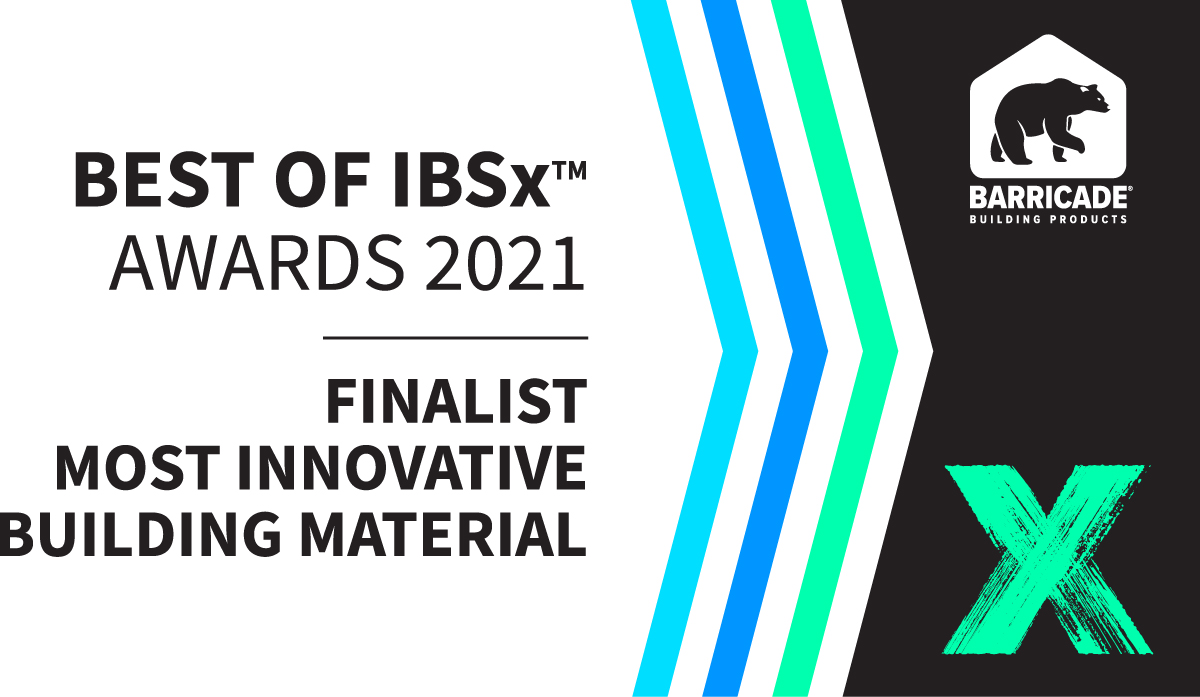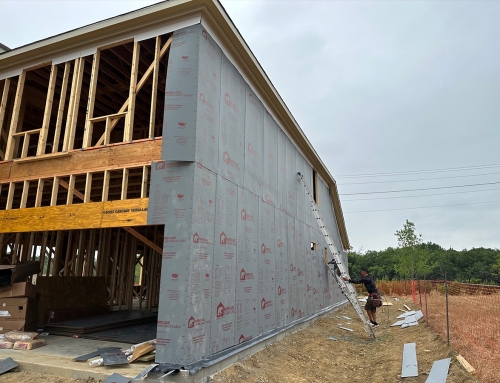As energy efficiency houses become the norm as opposed to the pricey exception, builders, designers, and homeowners are turning to products that tighten the building envelope. For years, the world of sheathing was dominated by plywood which was then supplanted by oriented strand board (OSB). Unprotected OSB is susceptible to rot which is how we ended up with house wrap.
The idea of developing a replacement for OSB that also includes an insulative quality and a weather barrier led Barricade Building Products to develop Thermo-Brace SIB, a sheathing that increases energy efficiency along with offering several other desirable features. Barricade makes a variety of home building components, including house wrap, but the SIB line of sheathing is in a class by itself. At the 2021 International Builders Show SIB won a Best of IBSx award as a Finalist for the Most Innovative Building Material.
The SIB Edge
“The SIB products have insulation built into them,” says Josh Elliott, Technical Director, Barricade Building Products. “SIB is the only thin wall sheathing product that is approved for installation with the foam out or the foam facing in toward the studs. With the new building codes, many locations will require more insulation in the walls. The rules are heading towards using either 2 x 6 walls with additional insulation in the wall cavity or 2 x 4 walls with continuous exterior insulation, which SIB provides.”
Continuous exterior insulation is the key phrase when it comes to improving a home’s energy usage. Many of the other insulated sheathing products on the market are made from expanded polystyrene (EPS). Styrene is an inexpensive, synthetic, resin-based polymer that shows up as packing peanuts, DVDs, plastic forks, and house sheathing. It does a decent job as an insulative barrier but doesn’t offer all the benefits of SIB, thanks to a not-so-secret ingredient.
Going with Graphite
Instead of just relying on EPS as an insulator, Barricade looked to other sources for materials that would perform better. The search landed on Neopor Graphite Polystyrene, which was developed by the chemical giant BASF company, based in Germany.
Neopor differs from EPS because it adds graphite into the mix. “It is a strong, long-lasting insulation,” says Elliott. “The Neopor has graphite in the foam to give it the grey color versus your normal white EPS. The graphite causes internal reflection in the foam giving it a better R- value.”
According to BASF’s distributor, Progressive Foam based in Chestnut Ridge Ohio, Neopor, “can provide up to twenty percent more energy savings than traditional white EPS insulation.” Heat by its nature transfers to colder spaces. When that happens through doors, windows, or insulated panels it’s called, “thermal bridging.” While EPS provides a barrier to thermal bridging, the heat that does get through moves on a straight path. Adding graphite to the foam creates an obstacle course of reflective components. Going around the graphite slows heat transfer.
Figuring out how to get the graphite into the boards took some ingenuity. According to Progressive Foam, “To convert Neopor into rigid insulation boards, the graphite beads are injected into a mold then hit with steam, which causes them to expand until they fill the mold. Depending on the shape of the mold, the pieces are either ejected from the mold and packaged or cut to their finished shape with hot wires.”
Running Hot and Cold
Changes in temperature including high heat and extreme cold conditions are more reasons to consider using Barricade’s SIB panels. Polyisocyanurate (Polyiso), is another popular choice for insulated sheathing despite its reputation for losing insulative quality when the temperature drops.
According to Mike Reynolds writing for EcoHome, “The news of Polyiso’s R-value petering out when you need it most still hasn’t permeated entirely through the building industry, so you still see it being installed occasionally on the exterior of walls in cold climates. It won’t offer nearly the thermal protection you think it will in the dead of winter, and it may cause moisture damage due to its lack of permeability.”
High heat is another concern that frequently comes up in comparisons about insulated sheathing – especially related to exterior siding. Vinyl siding has been taking a beating from the outside and the inside. Low emissivity (Low-E) glass is quickly moving into mainstream homebuilding and bringing some new wrinkles with it.
Low-E windows are designed to reflect the sun’s room warming rays while still letting in the light. When infrared and ultraviolet rays get reflected in just the right conditions on the house next door, the siding melts. The Low -E glass can act just like a magnifying glass.
Heat inside the walls is another issue. Barricade counters the interior heat concern by including a “Safe-Reflective-Facer,” layer on SIB that is guaranteed not to overheat vinyl. “Our bright white SIB facer will still provide a heat reflective surface without any possible heat issues,” says Elliott.
Added Value
In addition to insulative qualities, sheathing is also judged by how well it repels water and vapor, which are the main ingredients needed for growing black mold. OSB solves the problem by adding a layer of house wrap and then taping the seams to seal up the envelope.
Barricade’s SIB offers a weather-resistant barrier (WRB) already built-in on both sides of the board. SIB shows up on the job site or lumber yard as a more flexible and lighter package. “It’s lighter weight than OSB which does not contain any insulation, whereas our SIB comes in R-3 and R-5 configurations,” says Elliott.
The Zip system is one of SIB’s major competitors and while name recognition counts for something, it doesn’t tell the whole story. “The SIB is lighter weight and easier to cut,” says Elliott. “The SIB also provides insulation where the standard ZIP product does not.”
Barricade’s Thermo-Brace is strong enough to walk on and can be butted or overlapped. Foil facings are available for added energy performance. Thermo-Brace also has a higher shear value than other wall sheathing and is dimensionally stable. All grades provide racking resistance, and it can be used as an alternative corner bracing method, with structural ratings equivalent or better than OSB. It can be ordered in custom sizes at no extra charge and carries a 10-year warranty. All Thermo-Brace’s family of products are proudly made in Doswell, Virginia.
For more information about Thermo-Brace or our family of products come visit us the International Builder’s show this year in Orlando, Florida. Click on the banner below to get a free pass.









